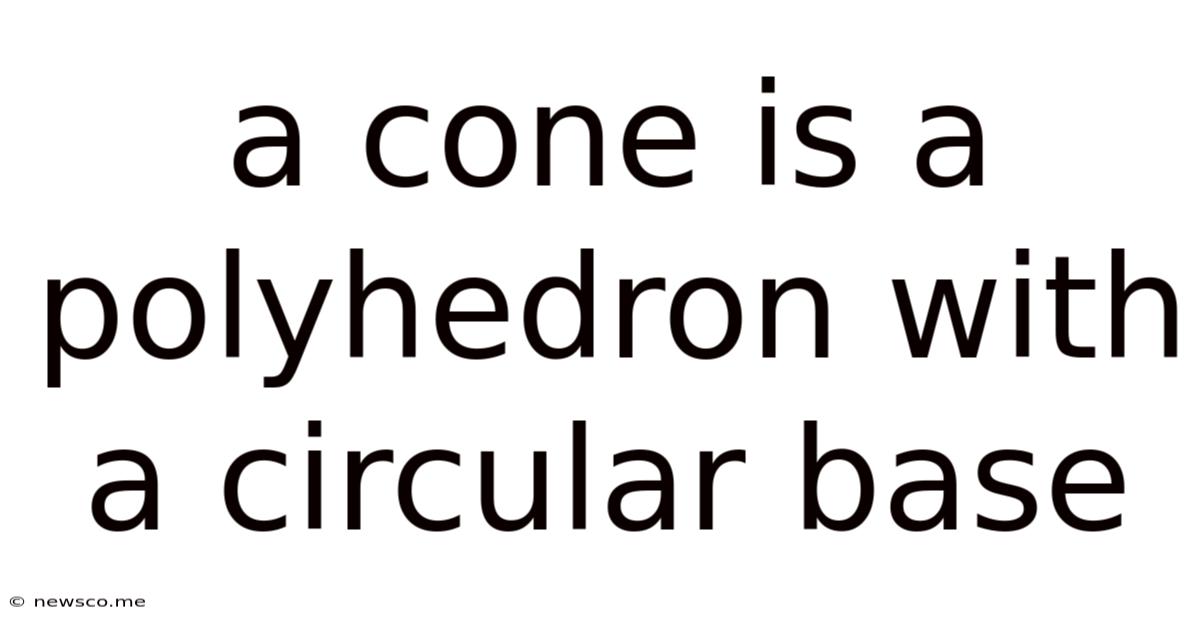A Cone Is A Polyhedron With A Circular Base
News Co
Apr 28, 2025 · 4 min read

Table of Contents
Is a Cone a Polyhedron with a Circular Base? A Deep Dive into Geometric Definitions
The statement "a cone is a polyhedron with a circular base" is incorrect. While a cone shares some similarities with polyhedra, it fundamentally differs in crucial aspects, primarily in its surface composition. This article will delve into the precise definitions of cones and polyhedra, highlighting their distinctions and exploring the characteristics that make each geometric shape unique. We'll also touch on related concepts and explore common misconceptions.
Understanding Polyhedra: The Building Blocks of 3D Geometry
A polyhedron is a three-dimensional geometric shape with flat polygonal faces, straight edges, and sharp vertices (corners). Crucially, a polyhedron is entirely composed of flat surfaces; there are no curved surfaces allowed. Think of common examples like cubes, pyramids, and octahedra. These shapes can be described by their number of faces, edges, and vertices, and obey Euler's formula (V - E + F = 2), where V represents vertices, E represents edges, and F represents faces.
Key characteristics of Polyhedra:
- Flat Faces: Each face is a polygon (triangle, square, pentagon, etc.).
- Straight Edges: The edges are the line segments where the faces meet.
- Sharp Vertices: Vertices are the points where three or more edges intersect.
- Finite Number of Faces: Polyhedra have a definite, countable number of faces.
Understanding Cones: A Smooth, Curved Surface
A cone, on the other hand, is a three-dimensional geometric shape that consists of a circular base and a single curved lateral surface that tapers smoothly to a point called the apex or vertex. Unlike a polyhedron, the cone's defining characteristic is this continuous, curved surface. It doesn't have flat faces or straight edges in the same way a polyhedron does.
Key characteristics of Cones:
- Circular Base: The base is a perfect circle.
- Curved Lateral Surface: The surface connecting the base to the apex is smoothly curved, not flat.
- Single Apex: All points on the curved surface meet at a single point, the apex.
- Height and Slant Height: The cone has a height (the perpendicular distance from the apex to the base) and a slant height (the distance from the apex to any point on the circumference of the base).
Why a Cone is NOT a Polyhedron
The fundamental difference between a cone and a polyhedron lies in the nature of their surfaces. Polyhedra are defined by their flat, polygonal faces. Cones, however, possess a curved lateral surface. This single crucial distinction disqualifies cones from being classified as polyhedra.
The presence of a curved surface violates the very definition of a polyhedron. The formula for Euler's characteristic (V - E + F = 2), which applies to polyhedra, cannot be applied directly to a cone because the concept of faces and edges is fundamentally different. While you might try to approximate a cone using many small polygons, this is just an approximation; a true cone has a continuous, smooth curve.
Addressing potential misunderstandings
Some might argue that a cone can be approximated by a pyramid with a large number of sides. This is true, and this approximation is often used in calculus and other areas of mathematics to analyze the cone's properties. However, this approximation doesn't change the fundamental nature of the cone. No matter how many sides the approximating pyramid has, it will still remain a polyhedron – a collection of flat faces. The cone, however, remains a distinctly different object with a curved surface.
Exploring Related Geometric Shapes
To further solidify the distinction, let's examine other closely related shapes:
Pyramids: A type of Polyhedron
Pyramids are indeed polyhedra. They have a polygonal base and triangular lateral faces that meet at a single apex. While a pyramid with a very large number of sides resembles a cone, it's still fundamentally different due to the presence of flat faces.
Truncated Cones: Still not Polyhedra
Even if we truncate (cut off) the apex of a cone, the resulting shape still retains its curved lateral surface. A truncated cone, although visually different, still doesn't meet the requirements of a polyhedron.
The Importance of Precise Geometric Definitions
The accurate definition and classification of geometric shapes are critical in various fields, including:
- Mathematics: Precise definitions are the foundation for rigorous mathematical proofs and theorems.
- Engineering and Design: Understanding the properties of different shapes is crucial for designing structures, machines, and products.
- Computer Graphics and 3D Modeling: Accurate geometric definitions are essential for creating realistic and functional 3D models.
Conclusion: A Clear Distinction
In conclusion, while a cone may share some superficial similarities with certain polyhedra (like pyramids), it's definitively not a polyhedron. The presence of a curved lateral surface fundamentally distinguishes it from polyhedra, which are exclusively composed of flat polygonal faces. Maintaining clear and precise definitions in geometry is crucial for accurate understanding and application in various fields. The difference between a curved surface and a flat surface is fundamental, making the distinction between cones and polyhedra irrefutable. Understanding this difference allows for a more complete and accurate understanding of three-dimensional geometry.
Latest Posts
Related Post
Thank you for visiting our website which covers about A Cone Is A Polyhedron With A Circular Base . We hope the information provided has been useful to you. Feel free to contact us if you have any questions or need further assistance. See you next time and don't miss to bookmark.